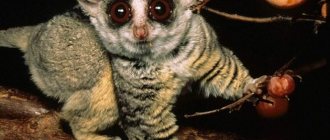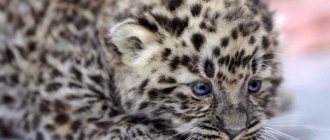The Far Eastern forest cat is a close relative of the Bengal cats that are so popular today and live in the territory adjacent to it. Amur cats, as they are also called, are the smallest representatives of the cat family in Asia.
These cats are so secretive and cautious that their exact numbers still remain a mystery to researchers. The species is listed in the Red Book as endangered and is protected by the state.
Appearance
The Amur forest cat is only slightly larger in body size than domestic cats. The entire adult male usually does not exceed 6-8 kg, especially large specimens can weigh up to 15 kg. Females are more graceful and noticeably smaller.
- The body length of a wild cat can reach 90 cm, with at least 1/3 of it being the tail. The average tail length of the individuals that naturalists were able to measure is 35-37 cm.
- The body of the Far Eastern wild cat is elongated, strong and well-built.
- The head is small compared to the body, the tail is thin and long.
- The ears are small, widely set, slightly tilted forward, which is typical for many felines, and there are no tassels at the ends.
- The eyes, on the contrary, are large and expressive, located close to each other.
- The nose is wide, flat with a brown nose. The vibrissae pads are well defined and complement a strong and rounded chin.
Although the Far Eastern cat is similar to domestic tabby cats, few of them can boast such a fluffy and warm coat. The fibers of its dense fur can reach a length of 5 cm.
Color of Far Eastern cats
The smallest among Asian cats, they have a protective coloring that makes them almost invisible among trees and shrubs. The upper part of the body is darker, the basic tone can vary from grayish-yellow to gray-brown.
Along the ridge there are 3 longitudinal stripes of brown color, formed by the merging of narrow spots. In some individuals these stripes merge into one wide one. The throat under the chin is decorated with 4-5 transverse stripes of reddish-brown color.
There are clear stripes on both the forelimbs and the muzzle. The thin and elegant tail is usually colored in a single color in reddish or black-gray, but there are also contrasting rings in black or gray.
Dark red spots, blurry or clearly defined, are scattered throughout the body. In the abdomen and groin area they are lighter.
This coat color is reminiscent of ancient Chinese coins, which is why in the Celestial Empire Amur forest cats are called “money cats.”
Lifestyle and nutrition
The Far Eastern forest cat leads a solitary life, gathering in groups of several individuals only during the mating period. One individual usually covers 4-9 km²; it does not leave this territory and guards the boundaries of its property. Migrations occur only in the absence of the proper amount of food.
Within its territory, the cat has several shelters, which are rock crevices hidden from prying eyes by thickets of bushes, abandoned badger and fox holes, and hollows of old trees. In favorable times, the animal periodically visits all its makeshift homes, but for the winter it remains in the warmest and most protected one.
During periods of prolonged snowfall, the Amur cat may not leave its home for weeks, waiting for the weather to improve and crust to form. Their paws are not adapted to move on loose snow, and their modest size makes this activity almost impossible.
They begin to hunt at dusk, waiting for prey in ambush on a tree or in the bushes. Surprisingly, a Far Eastern cat only needs one precise jump to overtake an unfortunate mouse or squirrel.
The diet of this predator consists of small mammals such as hares, chipmunks, and mouse-like rodents. The forest cat also hunts birds, often destroying their nests and feasting on eggs. Sometimes it attacks small ungulates - young roe deer and deer, and catches fish.
In addition to the above, the Amur cat can eat frogs and other amphibians, as well as insects. He does not disdain the remnants of the feast of his larger brothers - the leopard or the tiger.
The lifestyle and character of the Far Eastern forest cat have been little studied, since this animal is very secretive and tries to avoid human habitation. However, in particularly harsh winters it can come close, trapping rodents in barns and stealing poultry.
In case of danger, the Amur cat hides in a tree, but if a skirmish cannot be avoided, it defends itself very fiercely and does not retreat, even if the enemy surpasses it in size and strength.
The hunters went crazy
As Pavel Fomenko clarifies, according to official accounting data in 2015, in the Primorsky Territory, on the right bank of the Amur in the Khabarovsk Territory, in the Jewish Autonomous Okrug and the Amur Region. there were only 540 tigers. Today there may be about 600 of them. At the same time, Amur tigers live not only in nature reserves and national parks: 80% of their population lives in unprotected forests and hunting grounds. 10% of tigers live in China, where the death penalty is imposed for killing the “divine beast”. But poachers are still pursuing them.
Article on the topic
The forest is cut down - the tigers flee. Why did predators begin to approach people more often? “People are often driven to kill a tiger by necessity,” explains Fomenko. “In addition, there have always been, are and will be conflicting tigers that attack livestock and domestic animals.” Due to the lack of ungulates in the taiga, injuries or diseases, striped predators sometimes come to villages for livestock and dogs. For example, the snowy winter of 1983–1984. led to the catastrophic death of tens of thousands of ungulates in the north of Primorsky and southern Khabarovsk Territories. As a result, in 1985, according to official data alone, 20 tigers were shot in Primorye, in 1986 - already 43. According to Vasily Solkin, the overwhelming majority of residents of Primorye have never seen a tiger in the wild: “However, current hunters (excluding representatives of indigenous peoples), one might say, have become “unhinged” towards the tiger: they behave more aggressively, often not out of anger, but out of fear. Especially when it comes to a hunting area, where your well-being depends on the number of sables you kill. And from morning to evening you are bothered by a huge predatory cat, whose mere presence causes irritation. This results in a confrontation between beast and man.”
Reproduction
According to some sources, Amur cats reach sexual maturity at the age of 8-10 months, according to another version only at 1.5 years. As expected, the breeding season of the leopard cat is in March. Some experts claim that these animals are monogamous, although this is not typical for cats.
If two gentlemen are courting a female, skirmishes and fights between them cannot be avoided. Fights are accompanied by hissing and wild screams, the winner gets the right to mate and procreate, the loser leaves.
Kittens are born after 65-70 days, usually 1-2, less often 4. Newborn kittens are blind and helpless, their weight is only 70-80 g. At first, they spend most of the day sleeping, waking up only to eat. Both parents look after the babies. The female is constantly on the alert, and sensing the slightest danger, she takes them to another place.
Kittens grow quickly and already at 1.5 months they get out of the shelter to explore the surrounding area. Young cats do not stay near their mother any more than necessary. At the age of 6-7 months, they finally leave their parents’ den and go in search of their own hunting grounds.
Amur forest cat in captivity
The Far Eastern forest cat is kept in some zoos, but even with everyday interaction with people, it is absolutely not amenable to domestication. They reproduce well in captivity, but they are always wary of humans.
Forest cats are fed once a day with live small rodents and birds. The life expectancy of the Amur cat in the natural environment is 8-10 years, in captivity up to 17 years.
At home, the Amur forest cat can only be kept in a spacious enclosure. Even if you take a kitten 3 months old and raise it in a family, the animal will pose a danger as an adult. Particularly aggressive behavior is observed in cats during periods of acute sexual desire.
Origin story
According to the latest scientific data, wild cats appeared during the Pleistocene period, which ended approximately 11,700 years ago and was characterized by extremely harsh climatic conditions. The alternate advance and retreat of glacial masses on the world's continents caused abrupt climate change, which served as the impetus for a strong intensification of speciation processes. This led to the generation of a wide variety of new forms in the animal and plant world, more adapted to real living conditions (woolly rhinoceroses, mammoths, giant deer, cave lions, etc.). Not all animals were able to adapt to the constantly changing climate; many became extinct. But the cats succeeded, they mastered dense forests and highlands for living.
Wild cats have lived on earth for almost 12 thousand years
Scientists believe that the domestication of cats occurred when people took up farming and began to lead a sedentary life. They stored grain crops, which attracted many rodents. Which, in turn, became easy prey for cats.
Status and protection
The Amur forest cat is listed in the Red Book of the Russian Federation and is protected by the international CITES Convention as an endangered species. Nowadays, according to researchers, the population of wild cats has begun to grow.
In our country, Far Eastern cats inhabit several biosphere reserves:
- Cedar Pad (Primorsky Territory);
- Khankaisky (Primorsky Territory);
- Ussuriysk (Primorsky Territory);
- Lazovsky (Primorsky Territory);
- Bolshekhehtsirsky (Khabarovsk Territory).
The main threat to cats in the Far East is the reduction of natural habitats due to deforestation. Another important factor is the possibility of crossing with an ordinary domestic cat, as a result of which the genetic purity of the species is lost.
Habitats
The Amur forest cat, like many other inhabitants of the Far East, is endemic. It is not found anywhere else. This predator inhabits the entire length of the Amur River, on the coast of the Sea of Japan, in the area of lakes Khanka and Khasan, on the Hindustan Peninsula, as well as practically throughout the entire territory of China up to the Malay Islands.
He feels especially comfortable in nature reserves: Khankaisky, Ussuriysky, Lazovsky, Kedrovaya Pad. This is explained not so much by safety (the Amur cat has never been hunted on an industrial scale), but by the distance from human settlements.
This predator is also found on some of the Japanese islands. In fact, this is where one of its names came from: “Leopard Cat of Tsushima.”
It lives mainly in grassy floodplains, deciduous or mixed forests. It is less common in the taiga, although even there you can see its spotted skin. In Pomorie, its main habitat is shrubs and reed lowlands along the banks of oxbow lakes and lakes. In these places you can often find the name “reed cat”: it is not entirely correct, since a completely different representative of the cat family has the same name, but it well reflects the lifestyle of the Amur predator.
The Far Eastern cat feels quite confident on the rocks, although it does not climb high into the mountains. The reason for this is the snow that accumulates between the stones in winter (the maximum depth of snow cover at which a predator can hunt is 30-40 cm).
With the beginning of winter, the cat hides in the nest and does not leave it until a strong frozen crust forms on the surface of the snow, capable of supporting the weight of the animal. The only exceptions are cats feeding their cubs, and those of their cats who were unlucky in hunting before the blizzard.
https://youtube.com/watch?v=tFTN2vgy_zQ











